Maths around the clock
On clock dials you find the numbers from 1 to 12 — but for a bit of a change, could you write those numbers in a different way?
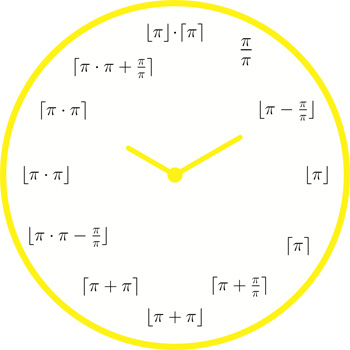
A π clock. See below for more examples.
The answer is yes. For example, you can write  as
as  or
or  or
or  by using the sum, the product, or by raising to a power. If you like the number
by using the sum, the product, or by raising to a power. If you like the number  you could also write
you could also write  as
as  by using the ceiling function, which approximates
by using the ceiling function, which approximates  from above with the closest integer. There are infinitely many possibilities for expressing the number
from above with the closest integer. There are infinitely many possibilities for expressing the number  , and which one is the best is a matter of personal preference. In general, you can produce your own exclusive mathematical clock by writing
, and which one is the best is a matter of personal preference. In general, you can produce your own exclusive mathematical clock by writing  to
to  in your favourite way.
in your favourite way.
If you are looking for something extremely fancy, you can use Euler's identity to express  using the numbers
using the numbers  ,
,  , and the imaginary number
, and the imaginary number  :
:

Or, if you like the Basel problem you could display  as the inverse of the sum of all reciprocals of the squares of the positive multiples of
as the inverse of the sum of all reciprocals of the squares of the positive multiples of 
![\[ 1/6=\frac{1}{(\pi )^2}+\frac{1}{(2\pi )^2}+\frac{1}{(3\pi )^2}+\frac{1}{(4\pi )^2}+\frac{1}{(5\pi )^2}+\ldots \]](/MI/e5a24ede4c1c699c2be69089ebea0c37/images/img-0001.png) |
For something more concrete, you can pick any digit from  to
to  and express the numbers on the clock dial only with this digit and mathematical symbols (some examples are provided in the images below).
and express the numbers on the clock dial only with this digit and mathematical symbols (some examples are provided in the images below).
Much more generally, it is possible to write the integers from  to
to  by using only any given real number and mathematical symbols. The reason is that we can always find a suitable expression for the number
by using only any given real number and mathematical symbols. The reason is that we can always find a suitable expression for the number  . Indeed, for a positive real number which is at most
. Indeed, for a positive real number which is at most  , it suffices to take the ceiling function (ie taking the integer approximation from above) to produce
, it suffices to take the ceiling function (ie taking the integer approximation from above) to produce  . For any real number
. For any real number  greater than
greater than  we can write
we can write  as the floor function of
as the floor function of ![$\sqrt[x]{x}$](/MI/9f98e83c9b6cd7d90506d9abdfeb3b44/images/img-0004.png) (ie taking the integer approximation from below of the
(ie taking the integer approximation from below of the  -th root of the number
-th root of the number  ), as can be checked with the logarithmic identity
), as can be checked with the logarithmic identity
![\[ \sqrt[x]{x}=e^{\frac{\log x}{x}}\, . \]](/MI/9f98e83c9b6cd7d90506d9abdfeb3b44/images/img-0005.png) |
Finally, negative numbers may be turned positive with the absolute value, and for  one may use the factorial identity
one may use the factorial identity  .
.
There are plenty of mathematical clocks in circulation with various expressions on the clock dial. Occasionally, rather than having the numbers from  to
to  , you find the first twelve terms of some sequence. For example, you may have the first twelve Fibonacci numbers:
, you find the first twelve terms of some sequence. For example, you may have the first twelve Fibonacci numbers:
![\[ 1,1,2,3,5,8,13,21,34,55,89,144\, . \]](/MI/99cd59ab767a573d9244d5d35c790d46/images/img-0001.png) |
In the very same way, you could use the letters from  to
to  .
.
Another option is writing down an equation such that the desired number is the only solution, for example conveying  with
with
![\[ x^2+7=10x-18\, . \]](/MI/99cd59ab767a573d9244d5d35c790d46/images/img-0005.png) |
Some mathematical clocks show equations with more than one solution, but with exactly one solution among the integers from  to
to  . In general, beware of mathematical inaccuracies in mathematical clocks (for example
. In general, beware of mathematical inaccuracies in mathematical clocks (for example  is not really
is not really  )!
)!
Nevertheless, everything is allowed to have fun playing with numbers. We challenge you to produce your own mathematical clock, but if you need some inspiration here are some examples.
Mathematical Clock Themes
In the image gallery below you find various mathematical clocks, with alternative ways of writing the numbers from  to
to  . You can print out one of those images and use it as a clock dial (e.g. you buy a clock with a custom dial), or you can simply place selected numbers' expressions above or around your clock. You can also buy clocks that you can write on, which allow you to change your mathematical clock at leisure.
. You can print out one of those images and use it as a clock dial (e.g. you buy a clock with a custom dial), or you can simply place selected numbers' expressions above or around your clock. You can also buy clocks that you can write on, which allow you to change your mathematical clock at leisure.
Here are some examples:
1 to 9 clocks
Fix any decimal digit from  to
to  and then display all integers
and then display all integers  to
to  with short expressions involving only that digit and some arithmetic operations. We use the basic arithmetic operations, taking powers, and taking the square-root.
with short expressions involving only that digit and some arithmetic operations. We use the basic arithmetic operations, taking powers, and taking the square-root.
Here is an example of a 7 clock. Examples for 1, 2, 3, 4, 5, 6, 8, and 9 are given below (notice that with the digits 5, 6, and 7 we only use the basic arithmetic operations).
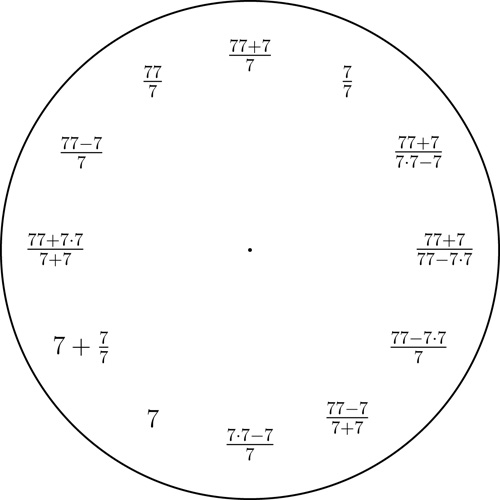
A 7 clock. Click here for a printable pdf of this clock face.
The 123 theme
It is possible to write all integers from  to
to  using only the digits
using only the digits  ,
, ,
, exactly once and in this order. We use the basic arithmetic operations, taking powers, taking the square-root, taking the factorial (the factorial of a natural number
exactly once and in this order. We use the basic arithmetic operations, taking powers, taking the square-root, taking the factorial (the factorial of a natural number  , denoted by
, denoted by  , is defined as the product of all natural numbers from
, is defined as the product of all natural numbers from  to
to  ), and applying the floor function
), and applying the floor function  (this function approximates a real number with the closest integer from below).
(this function approximates a real number with the closest integer from below).
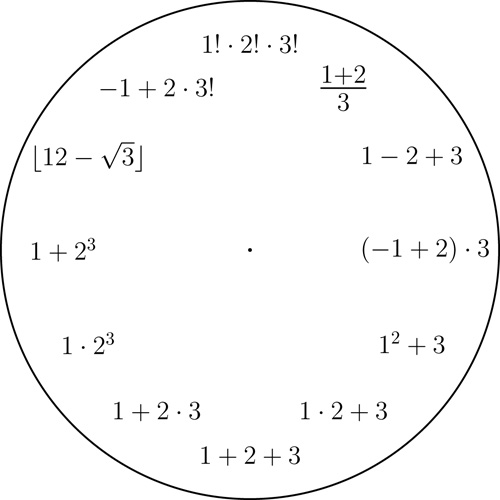
A 123 clock. Click here for a printable pdf of this clock face.
The π clock
It is possible to write all integers from  to
to  using only the number
using only the number  , the basic arithmetic operations, and the floor/ceiling functions
, the basic arithmetic operations, and the floor/ceiling functions  and
and  (these functions approximate a real number with the closest integer from below and above, respectively).
(these functions approximate a real number with the closest integer from below and above, respectively).
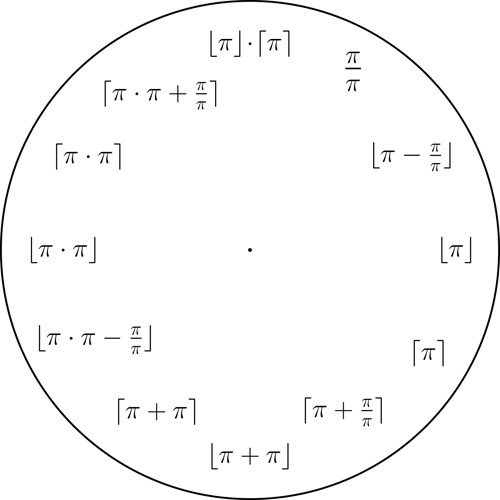
A pi clock. Click here for a printable pdf of this clock face.
The e clock
It is possible to write all integers from  to
to  using only Euler's number
using only Euler's number  , the basic arithmetic operations, taking powers, taking the square-root, and applying the floor/ceiling functions
, the basic arithmetic operations, taking powers, taking the square-root, and applying the floor/ceiling functions  and
and  .
.
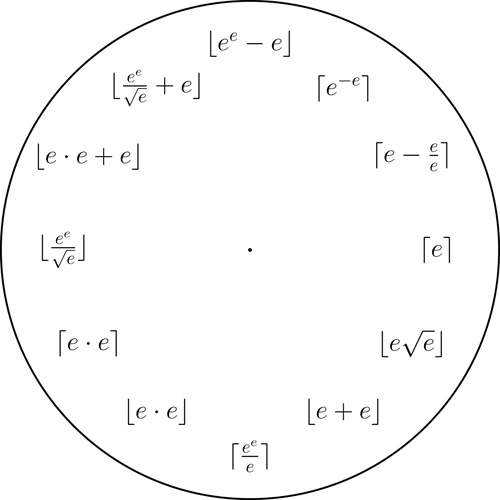
An e clock. Click here for a printable pdf of this clock face.
The binary clock
Here we write all numbers from  to
to  in the binary system, which only uses the digits
in the binary system, which only uses the digits  and
and  .
.
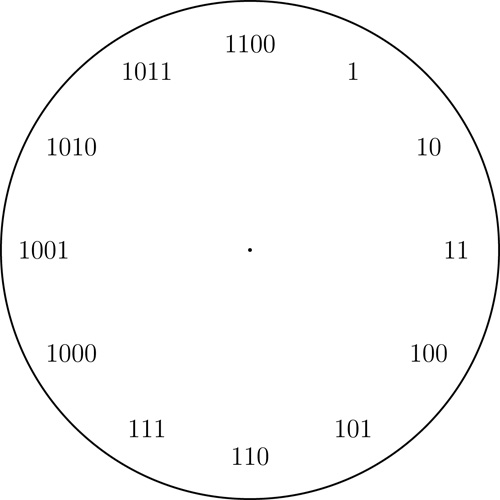
An binary clock. Click here for a printable pdf of this clock face.
The prime numbers clock
Here we only write those numbers from  to
to  which are prime numbers.
which are prime numbers.
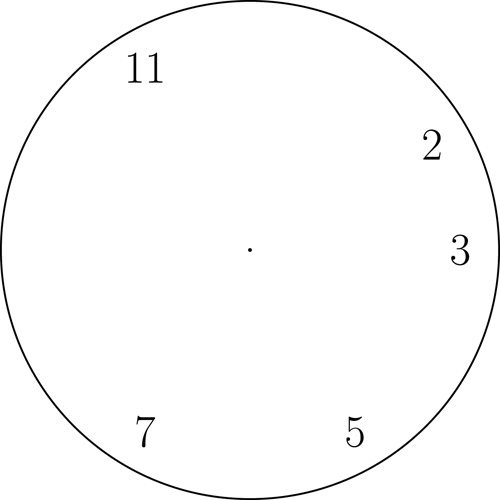
A prime number clock. Click here for a printable pdf of this clock face.
The Chinese numerals clock
Here we write all numbers from  to
to  using Chinese numerals: you may notice how the numbers
using Chinese numerals: you may notice how the numbers  and
and  are composed from the symbol for
are composed from the symbol for  and the numbers
and the numbers  and
and  respectively.
respectively.
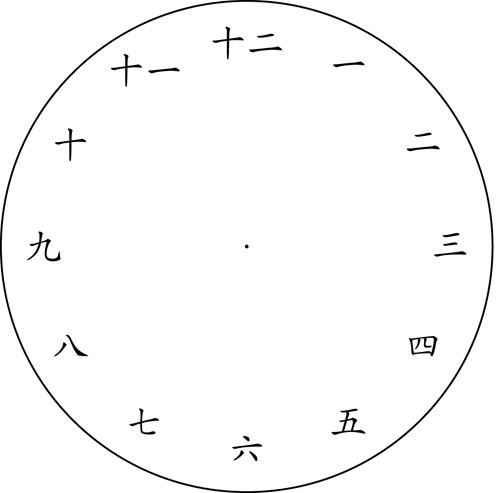
A Chinese numerals clock. Click here for a printable pdf of this clock face.
The Maya numerals clock
Here we write all numbers from  to
to  using Maya numerals: a dot stands for the number
using Maya numerals: a dot stands for the number  and a bar stands for
and a bar stands for  .
.
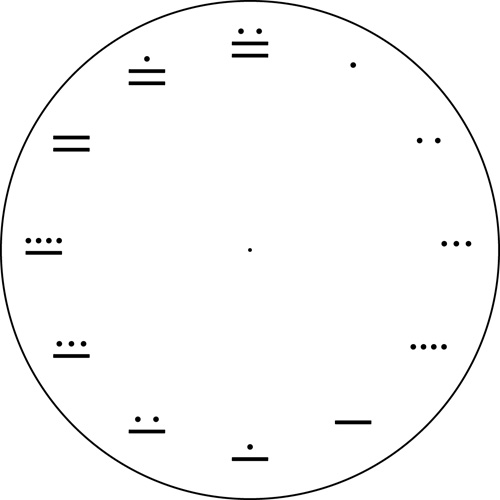
A Maya numerals clock. Click here for a printable pdf of this clock face.
The  clock, the
clock, the  clock, the
clock, the  to
to  clocks and the
clocks and the  clock were developed by the author (for the
clock were developed by the author (for the  theme, we got some inspiration from Math clocks).
theme, we got some inspiration from Math clocks).
More examples...
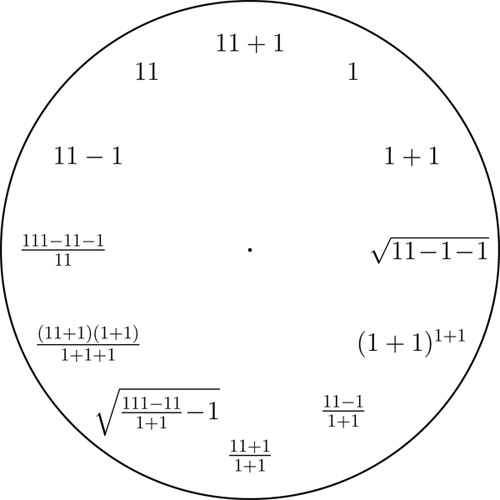
A 1 clock. Click here for a printable pdf of this clock face.
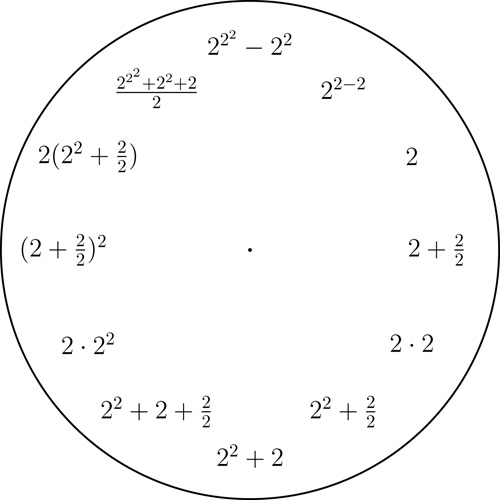
A 2 clock. Click here for a printable pdf of this clock face.

A 3 clock. Click here for a printable pdf of this clock face.
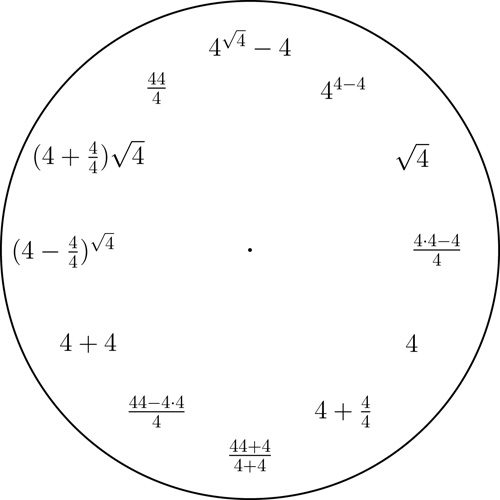
A 4 clock. Click here for a printable pdf of this clock face.
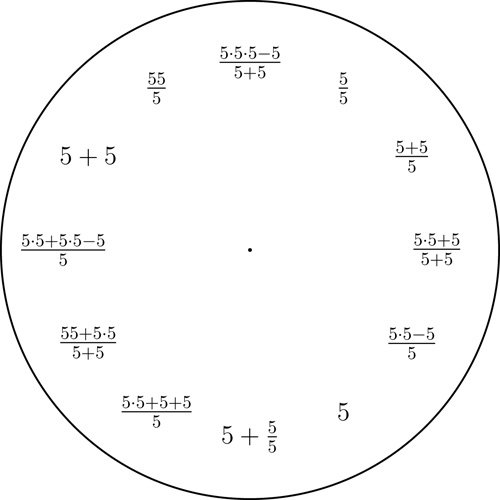
A 5 clock. Click here for a printable pdf of this clock face.
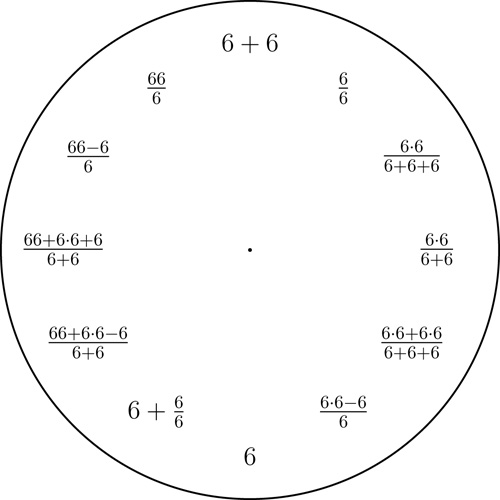
A 6 clock. Click here for a printable pdf of this clock face.
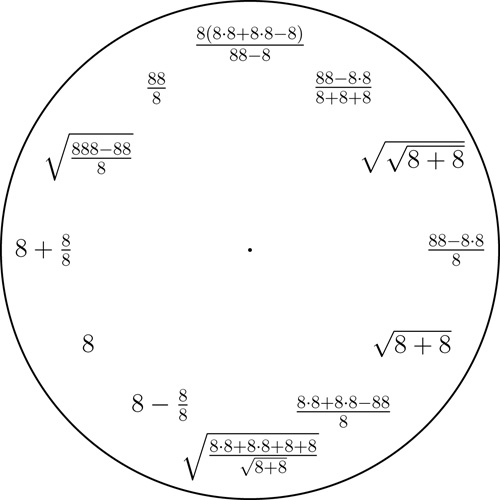
A 8 clock. Click here for a printable pdf of this clock face.
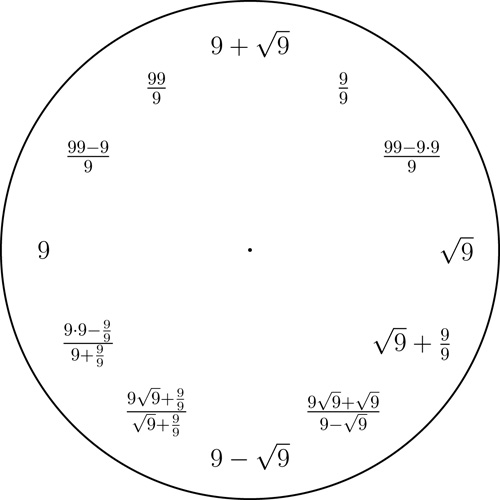
A 9 clock. Click here for a printable pdf of this clock face.
About the author

Antonella Perucca is Professor for Mathematics and its Didactics at the University of Luxembourg. She is a researcher in number theory and invents mathematical exhibits (for example the "Chinese Remainder Clock"). To find out more, explore her webpage.